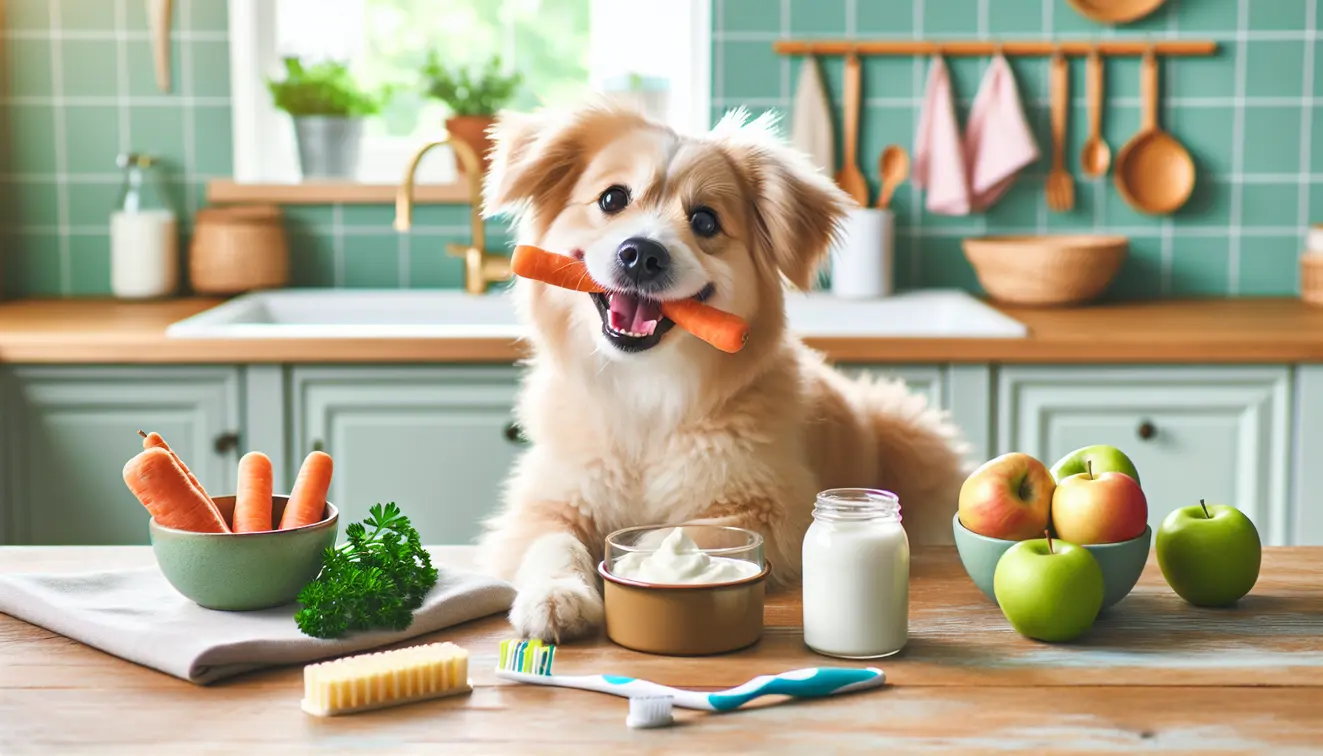Home Remedies for Dog Bad Breath: Safe, Natural Solutions to Freshen Your Pup’s Breath
Estimated reading time: 8 minutes
Key Takeaways
- Bad breath in dogs, or halitosis, often stems from dental hygiene issues, diet, or underlying health conditions.
- Safe, natural remedies like parsley water, coconut oil, and apple slices can help freshen breath for mild cases.
- Brushing your dog’s teeth is the gold standard for preventing and addressing odor.
- Persistent bad breath or accompanying symptoms require a vet’s attention to rule out serious issues.
- Prevention through diet, hydration, and routine care keeps your pup’s smile fresh long-term.
Table of Contents
- Introduction to Dog Bad Breath Concerns
- What Causes Bad Breath in Dogs?
- When Should You Consult a Veterinarian?
- Top 7 Safe and Natural Home Remedies for Dog Bad Breath
- How to Brush Your Dog’s Teeth at Home
- Preventative Tips to Keep Your Dog’s Breath Fresh
- Safety Warnings: What to Avoid When Treating Dog Bad Breath
- Common Questions About Dog Bad Breath (FAQs)
Introduction to Dog Bad Breath Concerns
Imagine curling up with your furry friend, only to be met with a whiff of unpleasant breath that pushes you away. Bad breath in dogs, often called halitosis, can turn sweet bonding moments sour. At WikiHomeRemedies, we’re here to guide you through safe, natural solutions to freshen your pup’s breath, drawing on veterinary insights and trusted sources like the American Kennel Club (AKC) and ASPCA.
The reality is, many dogs face this issue—studies suggest a significant number deal with dental woes that contribute to odor. Our goal is to help you understand the root causes, explore vet-aligned home remedies, and learn when professional care is needed. We’ll also share prevention tips to keep that tail-wagging smile fresh. Let’s dive in and tackle this common concern together, ensuring your dog’s health and happiness remain a priority. For more pet-related health tips, check out our guide on other common issues like ear infections in dogs.
What Causes Bad Breath in Dogs?
Bad breath in dogs isn’t just a nuisance; it’s often a sign of something deeper. Known as halitosis, this condition can stem from various triggers, ranging from simple hygiene lapses to health issues needing attention. Identifying the cause is the first step to finding the right solution and safeguarding your pup’s well-being.
Let’s break down the common culprits behind that unpleasant odor. Each plays a role in how breath turns foul, and understanding them helps you address the problem effectively:
- Poor Dental Hygiene: Plaque and tartar buildup on teeth trap bacteria, leading to stench over time.
- Dietary Issues: Low-quality food or lingering debris in the mouth can create persistent smells.
- Behavioral Habits: Dogs rummaging through garbage or eating feces often end up with foul breath.
- Health Conditions: Serious issues like gum disease, kidney trouble, or diabetes can manifest as bad breath.
Veterinary data from sources like PetMD reveals that dental disease affects a staggering number of dogs, often tied directly to halitosis. Pinpointing the reason behind your dog’s breath issue isn’t just about comfort—it’s about their overall health. Let’s explore these causes in detail to set the stage for solutions. If you’re curious about other health conditions affecting your pet, such as urinary tract issues, visit our resource.
Dental Hygiene Issues
When plaque and tartar build up on your dog’s teeth, they create a breeding ground for bacteria. This sticky film hardens over time, irritating gums and causing a noticeable odor. The AKC notes that around 80% of dogs over three years old show signs of dental disease, making hygiene a top concern for breath issues. Neglecting this can lead to more than just a smell—it risks painful infections. Addressing buildup early is key to a fresher mouth and a healthier pup. For more insights into dental care for pets, explore our article on teeth whitening.
Dietary and Behavioral Factors
What your dog eats matters more than you might think. Poor-quality diets or food debris stuck in teeth can fuel bad breath, while scavenging habits—think trash or worse—add to the problem. Pet owners often share stories on forums about how switching diets or curbing these behaviors made a difference. Veterinary advice points to consistent, quality meals as a starting point. Keeping an eye on what goes into their mouth helps tackle odor from the source.
Underlying Health Conditions
Sometimes, bad breath signals something beyond the mouth. Conditions like kidney disease or diabetes can alter breath as toxins build up in the body. Gum disease, too, often hides behind persistent odor, hinting at systemic issues. Vets stress the need for professional diagnosis when breath doesn’t improve, as stats from credible sources tie these health concerns to halitosis. If you suspect something deeper, a vet visit becomes essential before trying any remedy. For additional pet health concerns like yeast infections that might contribute to overall health issues, see our resource.
When Should You Consult a Veterinarian?
While home remedies can work wonders for mild cases of bad breath, they’re no replacement for a vet’s expertise. Persistent or worsening odor often points to problems that natural solutions can’t touch. At WikiHomeRemedies, we encourage a balanced approach—try safe methods at home, but know when to seek professional help for your dog’s sake.
Certain signs scream for a vet’s attention. Recognizing these red flags early can make all the difference in your pup’s health:
- Persistent bad breath that lingers despite hygiene efforts.
- Excessive drooling or difficulty eating, hinting at oral pain.
- Lethargy or unusual behavior alongside the odor.
- Visible damage to teeth or inflamed, bleeding gums.
The ASPCA and PetMD outline these as urgent symptoms needing immediate care. Don’t hesitate if you notice them—ruling out serious conditions ensures any home remedy you use is both safe and effective. Let’s look closer at spotting critical signs and why a vet’s diagnosis matters.
Recognizing Serious Symptoms
Keep an eye out for warning signs that go beyond a simple smell. These include:
- Inflamed or bleeding gums, suggesting infection or disease.
- Loss of appetite, often tied to oral discomfort.
- Swollen face or pawing at the mouth, indicating pain.
- Unusual discharge from the mouth or nose.
Vet insights from the AKC highlight these as potential dental emergencies. Acting fast on such symptoms prevents minor issues from escalating.
Importance of Professional Diagnosis
A vet can uncover hidden problems that home fixes can’t address. Through blood tests or dental exams, they might detect issues like kidney dysfunction tied to bad breath. Trusted pet health resources emphasize that systemic conditions require tailored treatment beyond natural remedies. Skipping this step risks missing a critical health clue. Always prioritize a professional check if doubt creeps in, ensuring your dog gets the right care. If you’re dealing with other pet health issues like hot spots that might indicate underlying problems, learn more at our resource.
Top 7 Safe and Natural Home Remedies for Dog Bad Breath
For mild cases of bad breath, nature offers gentle, effective solutions you can try at home. These seven remedies align with veterinary guidance where possible and focus on safety for most dogs. Before starting, check for allergies or specific conditions with your vet, and let’s explore how to freshen your pup’s breath naturally.
1. Parsley Water Rinse
Parsley holds a secret weapon—chlorophyll, which helps neutralize odors in the mouth. This simple rinse can lessen your dog’s bad breath with minimal effort. Boil a handful of fresh parsley in water, cool it, and strain. Here’s how to use it:
- Dip a clean cloth in the parsley water.
- Gently wipe your dog’s gums and teeth once daily.
- Alternatively, add a small amount to their water bowl if they’ll drink it.
Be mindful, though—parsley isn’t ideal for dogs with kidney issues. Herbal pet care references often praise its deodorizing power when used sparingly.
2. Coconut Oil Toothpaste
Coconut oil brings antibacterial strength to the table, making it a solid choice for oral care. Mixing a teaspoon with a pinch of baking soda creates a safe paste for dogs. Apply it like this:
- Use a soft toothbrush or finger brush for application.
- Rub gently on teeth and gums for a minute.
- Start with small amounts to prevent tummy upset.
Pet blogs and vet articles often highlight coconut oil as a go-to for breath and plaque control. Keep portions tiny—too much can lead to digestive woes.
3. Apple Slices as Chews
An apple slice can act as a natural toothbrush, scrubbing teeth as your dog chews. The texture helps clear debris while offering a tasty treat. Try this:
- Cut seedless, small slices for safety.
- Offer one or two as an occasional snack.
- Supervise to ensure they don’t choke.
Remember, apples carry natural sugars, so limit portions. The AKC supports this as a dental-friendly option when given with care.
4. Plain Yogurt for Gut Health
Probiotics in plain yogurt balance oral bacteria by supporting gut health, which indirectly freshens breath. A spoonful can make a difference. Use it this way:
- Mix a teaspoon into their regular meal.
- Choose unsweetened, plain varieties only.
- Watch for signs of lactose intolerance like diarrhea.
Studies on pet diets via PetMD back probiotics for overall wellness. Test small amounts first—some dogs may not handle dairy well.
5. Carrot Sticks for Dental Scraping
Carrots bring a crunchy texture that scrapes plaque off teeth naturally. They double as a low-calorie chew for breath improvement. Offer them like so:
- Give raw, small sticks suited to your dog’s size.
- Supervise chewing to avoid choking risks.
- Use as a treat, not a meal replacement.
Vets often endorse carrots for dental benefits. They’re safe for most pups when monitored during snack time.
6. Diluted Apple Cider Vinegar Rinse
Apple cider vinegar packs antibacterial properties that can combat mouth odor when used correctly. Dilution is critical to protect enamel. Prepare and apply it carefully:
- Mix one teaspoon of ACV with a cup of water.
- Dab on teeth with a cloth or add to their water bowl.
- Limit use to once or twice weekly.
Pet care forums and vet tips stress never using undiluted ACV—too much risks enamel wear or stomach irritation.
7. Fresh Mint Leaves (Small Amounts)
Mint offers a quick breath refresh with its natural aroma, but moderation is key. A tiny bit can help without harm. Use it as follows:
- Sprinkle a crushed leaf over food once a week.
- Avoid mint oils or extracts—they’re too strong.
- Stick to fresh leaves for safety.
Credible sources on herbal pet care note mint’s benefits when limited. Overdoing it can upset digestion, so keep portions minimal.
How to Brush Your Dog’s Teeth at Home
Brushing stands as the gold standard for fighting bad breath and dental issues in dogs. It clears plaque before it hardens, keeping odor at bay. Let’s walk through how to make this a stress-free habit for you and your pup, with tools and steps that work.
Tools and Preparation
Gather what you need to start brushing safely:
- A dog-safe toothbrush or finger brush for comfort.
- Pet-specific toothpaste—human versions contain xylitol, which is toxic.
- Treats for positive reinforcement after sessions.
- A calm space to avoid distractions during brushing.
Never use human products, as vets warn of serious risks. Having everything ready sets you up for smoother brushing.
Step-by-Step Brushing Guide
Follow these steps to build a brushing routine:
- Introduce the toothbrush slowly without paste first, letting them sniff it.
- Add a pea-sized dab of pet toothpaste they like.
- Lift their lip gently and brush in small circles for 30 seconds.
- Focus on outer teeth surfaces where plaque gathers most.
- Reward with a treat or praise to keep it positive.
Aim for 2–3 sessions weekly, building to daily if possible. Veterinary tips from the AKC stress patience—rushing can make them resist.
Tips for Reluctant Dogs
If your pup balks at brushing, try these workarounds:
- Start with finger brushing using a gauze pad or cloth.
- Offer dental treats as a temporary substitute.
- Keep sessions short, stopping before stress builds.
These steps ease them into the process. Persistence pays off for their oral health.
Preventative Tips to Keep Your Dog’s Breath Fresh
Stopping bad breath before it starts saves effort down the line. Prevention through diet, hygiene, and habits offers lasting benefits over reactive fixes. Let’s explore practical ways to maintain that fresh canine smile with simple daily choices.
Dietary Adjustments for Oral Health
What your dog eats shapes their breath. Consider these ideas:
- Switch to high-quality, dental-friendly kibble or food.
- Avoid table scraps that stick to teeth or cause odor.
- Consult a vet for diet plans supporting oral wellness.
The AKC suggests foods designed for dental health make a real impact. Consistency in meals curbs many odor sources.
Routine Oral Hygiene Practices
Keep their mouth clean with regular care. Try these routines:
- Provide veterinary-approved dental chews or toys.
- Schedule annual dental checkups with your vet.
- Use water additives for oral health if brushing isn’t daily.
Vet advice often points to chews as a supportive tool. Staying on top of hygiene prevents buildup.
Encouraging Hydration and Monitoring Habits
Small habits add up for fresher breath. Focus on these:
- Ensure constant access to clean, fresh water.
- Discourage scavenging in trash or eating harmful items.
- Watch outdoor behavior to limit bad pickups.
Hydration flushes debris, while curbing poor habits tackles odor at its root. These steps build a healthier routine.
Safety Warnings: What to Avoid When Treating Dog Bad Breath
Natural remedies help, but safety must come first. Certain foods and practices pose risks to your dog when addressing bad breath. WikiHomeRemedies urges caution to protect your pup while seeking solutions.
Avoid these toxic items that can harm more than help:
- Garlic and onions—cause blood cell damage even in small doses.
- Grapes and raisins—linked to kidney failure per ASPCA lists.
- Chocolate—contains theobromine, poisonous to dogs.
- Human toothpaste—xylitol triggers severe toxicity risks.
Overusing remedies also carries danger. Too much apple cider vinegar may erode enamel, while excessive yogurt can upset digestion. Watch portions and frequency with any home method. Most critically, don’t ignore ongoing bad breath—it could mask deeper issues. Let’s dive into specifics to keep your dog safe.
Toxic Foods and Substances
Steer clear of these harmful items when tackling breath issues:
- Garlic and onions disrupt red blood cells over time.
- Grapes or raisins risk acute kidney damage.
- Chocolate leads to heart and nerve problems.
- Human dental products often hide deadly ingredients.
The ASPCA’s toxic food list underscores these dangers. Always check before sharing anything with your pup.
Risks of Overusing Remedies
Moderation keeps natural fixes safe. Watch for these pitfalls:
- Excess apple cider vinegar wears down tooth enamel.
- Too much yogurt may cause digestive discomfort.
- Overdoing coconut oil risks diarrhea or weight gain.
Vet warnings note that balance prevents side effects. Stick to recommended amounts for each remedy.
Don’t Ignore Persistent Issues
If bad breath lingers, it’s more than a nuisance. It might signal gum disease or organ trouble needing a vet’s eye. Delaying care risks worsening hidden conditions. Reach out for professional help rather than relying solely on home solutions when the problem persists.
Common Questions About Dog Bad Breath (FAQs)
We’ve gathered answers to frequent questions about canine bad breath to clear up doubts. These quick insights tie into everything we’ve covered, offering clarity for your pup’s care.
Is Bad Breath in Dogs Always a Sign of Illness?
Not always, though it can be. Often, it’s tied to dental buildup like plaque, which isn’t immediately serious. However, persistent odor might point to gum disease or systemic issues like kidney trouble. Vet checks are wise if it doesn’t fade with basic care. Early action keeps minor problems from growing, as noted in ASPCA guidelines.
What Is Halitosis in Dogs?
Halitosis refers to chronic bad breath in dogs, beyond a passing whiff. It often stems from oral bacteria, poor hygiene, or deeper health concerns like diabetes. Addressing the root cause—whether dental or systemic—proves essential for relief. Trusted pet resources define it as a symptom worth watching. Keep an eye on patterns to gauge severity.
Which Home Remedies Are Safest for Puppies vs. Senior Dogs?
Safety varies by age with natural fixes. Consider these groupings:
- Puppies: Stick to apple slices or carrots—gentle on young teeth.
- Seniors: Try plain yogurt for gut support, avoiding harder chews.
- Both: Use diluted rinses sparingly; consult vets first.
Puppies need softer options, while seniors benefit from digestion aids, per AKC insights on age-specific care.
How Does Brushing Compare to Natural Chews for Breath Freshening?
Brushing tackles plaque directly, reaching spots chews can’t touch, making it more thorough. Natural chews like carrots offer convenience and some scraping action but lack precision. Vets via AKC note brushing wins for long-term health, though chews suit reluctant dogs as a start. Combining both often yields the best path to fresher breath.










